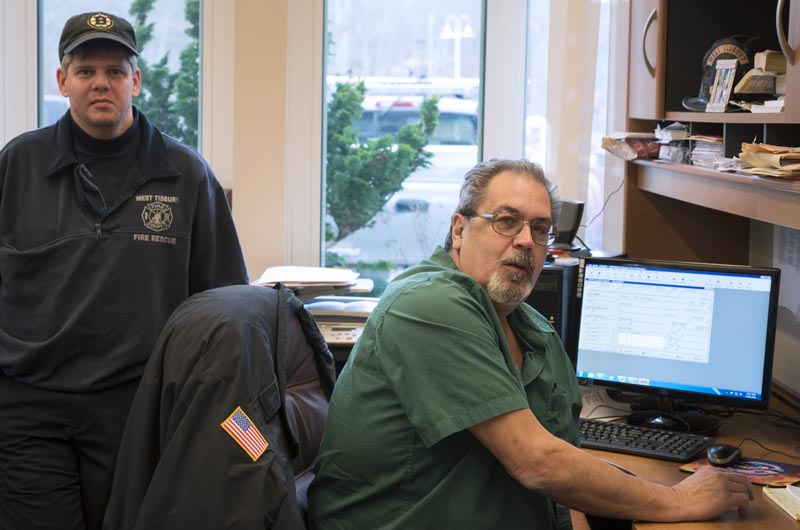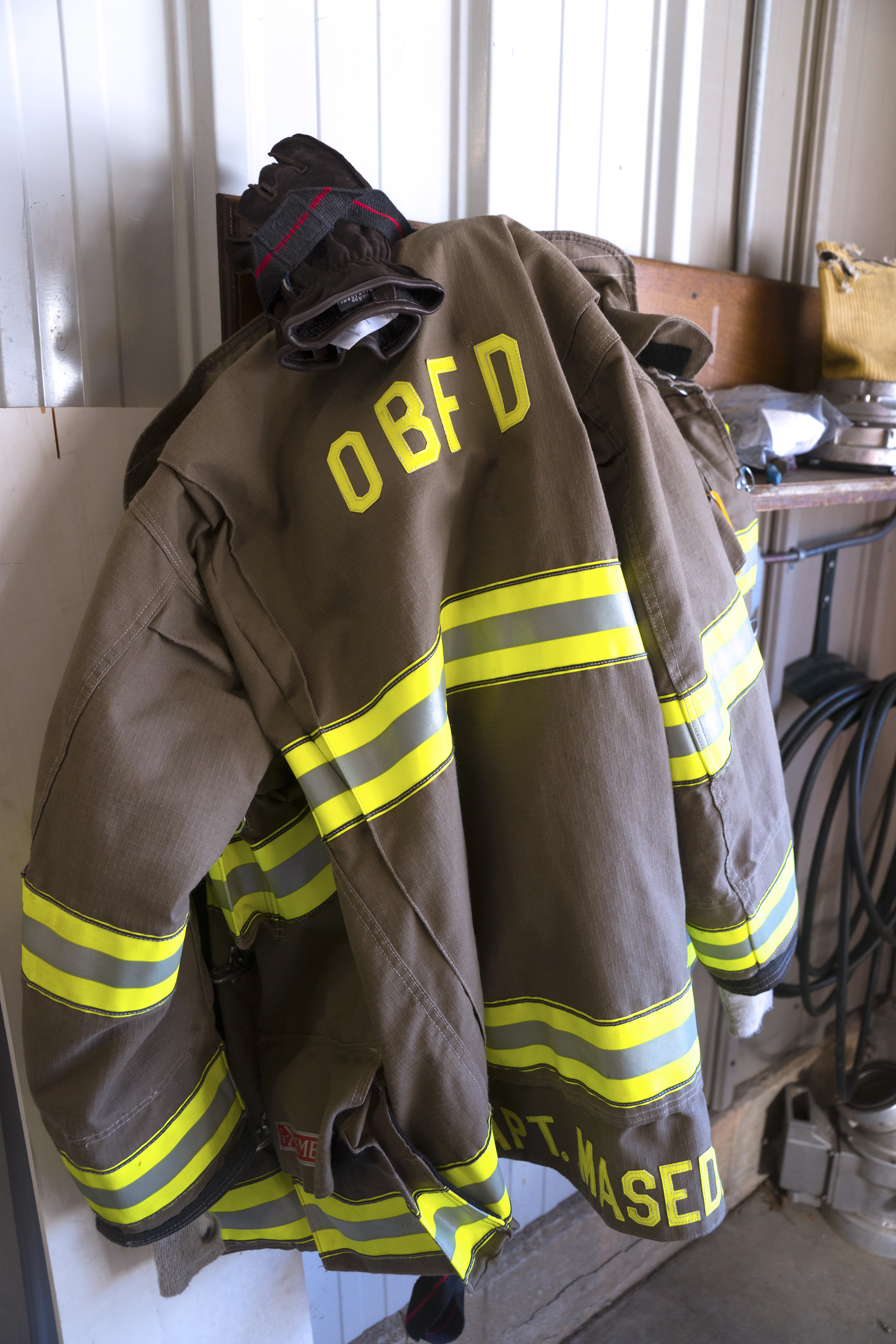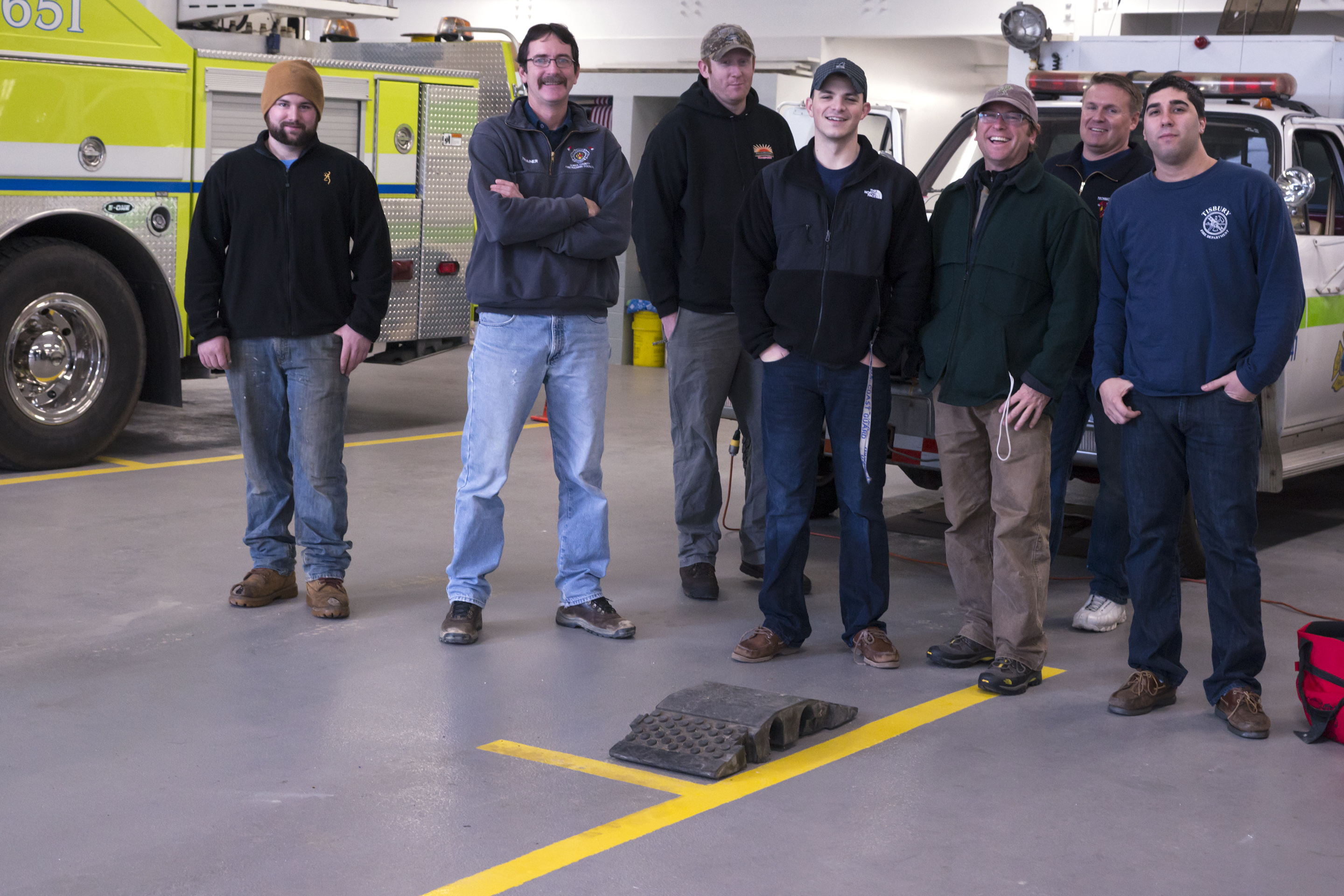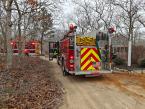There are roughly 217 firefighters on Martha’s Vineyard.
They are plumbers, police officers, carpenters, car mechanics, builders, bartenders, authors and artists. They drive the VTA bus and operate Bruno’s trash trucks. They work at Shirley’s.
They all carry black two-tone pagers that are about the size of a deck of cards. They clip them on their belts wherever they work, and place them in car cup holders while they drive. They have rescue gear that is kept at their station or in their truck. And on Sundays, they congregate at their respective stations to test their radios and sirens, care for their gear and maintain their engines. They drink coffee and share stories from the weekend, too.
They are labeled call firefighters, rather than volunteer, because they receive a stipend, yet everyone is in agreement that the amount, which varies by department but is under $1,000 a year, is not much compared to the amount of hours the call firefighters work.
“The stipend doesn’t even cover travel expenses like fuel to get to the meetings, drills and classes,” said John Rose, acting chief of the Oak Bluffs fire department.
The Aquinnah fire department, Chilmark fire department, Edgartown fire department, Oak Bluffs fire department, Tisbury fire department and West Tisbury fire department make up the six Island fire agencies.
Call firefighters must be able to follow directions under stressful conditions, be in good physical condition and be able to conduct themselves in a professional manner. They are taught to drive the engines, rescue people, put out fires and know CPR. They have to be prepared for anything — a car under water, a person in cardiac arrest, or a family trapped inside a burning building. Or it could be a false alarm.
Some call firefighters are fresh out of high school; others are knocking on the door of retirement.
The job of a call firefighter takes hours and hours of training. It is physically exhausting and requires an upsurge of energy, sometimes for 24 hours at a time. Some call firefighters work multiple jobs to make ends meet.
So why do they do it?
Ask Alexander Schaeffer, deputy chief of the Edgartown department, and he’ll say being a call firefighter is a way to give back to a community while learning about it.
John Shilling, Tisbury fire chief, will say it is about tradition and good will.
“Camaraderie. I love the camaraderie,” said West Tisbury chief Manuel Estrella 3rd. “It’s a group of us and we all get along and try to help the town out. It’s what we’ve been doing and what we’ll always be doing.”
There are no known academic studies to document that firefighting is a family affair, yet the proof is in the fire houses.
Edgartown has the Sylvias, Tisbury has the Maciels, West Tisbury, well, they have Maciels too. And you’d be hard-pressed to walk into the Oak Bluffs department and not run into a Rose.
“My uncle was a firefighter and so as a kid I spent a lot of time in the fire station,” recalled Mr. Rose. Now he works with his brother Manuel, the assistant chief for the OBFD, and his sisters, who are paramedics. Mr. Rose has a 21-year-old daughter, Amanda, who has recently been spotted around the station.
“She’s an EMT and is contemplating being a paramedic. We’ll see. It’s a huge commitment but truly a rewarding job,” Mr. Rose said.
While Mr. Rose’s daughter is not a firefighter yet, it’s not a long shot to speculate she one day will become one. A lot of EMTs start their career as firefighters, and a large number of firefighters are EMTs.
“We try to promote that within the department, for people to do both; it’s a lot of training but it’s worth it in the end,” Mr. Rose said.
Not many Island firefighters are women. But Trulayna Rose, now 32 years old, has been on the Oak Bluffs roster for 15 years. She joined the ranks as a junior firefighter.
“I grew up here, around the fire department,” Ms. Rose said. “My brothers would bring me to the station. I idolized my brothers and saw what they did. That’s one reason why I joined, because it’s like a big family, and I always wanted to be part of that.” Shortly after becoming a call firefighter and first responder, Ms. Rose became an EMT basic. Four years ago, she became a certified full-time paramedic.
“Being able to help somebody and know that I made a difference in a person’s life has made me keep going and that’s why I love my job,” she said. “Because I have always wanted to help people and now that is part of both my jobs. It’s rewarding.”
Oak Bluffs
With a roster of 60, Oak Bluffs makes up 27 per cent of Island firefighters.
“We are always busy,” Mr. Rose said. “We are in the middle of the two biggest towns and have the high school and the hospital, so we deal with things like transports, too.”
Mr. Rose estimated that the Oak Bluffs department, which works directly with the ambulance department, gets around 700 calls a year.
“So there can never be too many firefighters,” he said. “When the alarm sounds you never know where your firefighters will be coming from. Some have jobs they can’t leave.”
Mr. Rose, formerly a full-time plumber, knows this well. What is the solution to this?
“More call firefighters,” he said.
Edgartown
The Edgartown fire department has two locations, station one on Pease’s Point Way, right in the heart of town, and station two on Chappaquiddick. Forty-four firefighters including one chief, one deputy chief and one assistant chief make up the department.
“We’re your friends, neighbors, co-workers, brothers and sisters. We’re the people shopping next to you at the store,” said Alexander Schaeffer, deputy chief.
“Having everyone be a call firefighter means they have to keep up another job to be financially stable,” Mr. Schaeffer said.
The upside to this is that within every fire department there are experts in several fields.
“It’s been an invaluable resource for me,” said Mr. Schaeffer. “If a truck breaks down on scene we have firefighters who are expert car mechanics and I can task them to help with that. Some of them work full-time at the airport and that comes in handy with the airstrip out in Katama. We have builders, which is great to know how buildings are put together. A lot of the guys have jobs that are trades work — an oil burner technician, heating technician, electrician — seriously, name a field and we probably have one under our roof.”
Mr. Schaeffer has been a line cook, worked construction and did excavation for eight years. Then in 2000 he became an EMT. Five years after that he began working full time for the department. Yet his journey to firefighting is different from the rest.
“A lot of people have ties to the department. A grandfather, father, uncle. I didn’t. I didn’t always know that this is what I would do. That desire to run into a burning building? That was never there. I don’t have a great story, except for being dedicated to it. This place served as a great place for me to grow as an individual.”
Like Mr. Rose and the other Island firefighters, Mr. Schaeffer said there could never be too many call firefighters.
“We recently went to the high school twice to introduce ourselves and meet the kids,” he said. “Ten people signed up for the first time and six for the second. The students were from all the towns.”
For the first time the school will be offering vocational credits to students who enroll in the fire program.
Tisbury
“Tisbury averages about 40 firefighters on our roster,” said Chief John Schilling. This includes a chief officer (Mr. Schilling) and two assistant chiefs.
“We have also averaged one female for about 20 years,” Mr. Schilling said. “It hasn’t been the same one, but we’ve always had one.”
Mr. Schilling used to be a full-time independent insurance broker.
“Now doesn’t that prepare you for the fire service?” he joked.
He joined the department in 1980 because of his father.
“I grew up in a family where both my father and grandfather were town officials and served, and it was just the natural thing to do, to serve part of the community. When I first joined it was an easy way to make a difference in somebody’s life locally. It was just one of those things you did if you were a local fella here. Out of high school, if you had a job and were in the community, then you joined the department, of course!”
While the call firefighters on the Island have gone down in numbers in the past 20 to 30 years, Mr. Schilling remains hopeful for the future.
“If you were to put all the firefighters together in one room and start talking to them about what they do, you would think, there’s no way these people would all get together,” Mr. Schilling said. “But it’s the fire department that is the common thread for these people. It’s so diverse. That’s what makes it very exciting. Look at Martha’s Vineyard and that’s who you see. You see young and old.”
Mr. Schilling, now in his late 50s, said the range of ages on the Tisbury squad presents some unique challenges.
“How you communicate through three generations of technology is very unique. Young people on smart phones will reply back to a text quicker than some of the older generations. The older generations will say, ‘I don’t have texting but I have email, or I have email but I don’t text.’ And it really is interesting.”
“There are people who can share 30 to 40 years of experience with young people, and then there is enthusiasm and drive and a ‘go for it!’ attitude of the 20-somethings that motivates everyone along,” he added.
West Tisbury

Chief Estrella said there are around 40 call firefighters on the West Tisbury roster.
According to Mr. Estrella, who was “born and brought up” on the Island and retired last year from being the head custodian at the West Tisbury School, the department has always been about camaraderie, tradition and being part of something.
Take for example West Tisbury call firefighter Marques Rivers. Before he was old enough to drive, Mr. Rivers used to ride his bicycle (with a red light) to the Oak Bluffs fire station when his pager would go off.
Now 31 and a member of the West Tisbury department, Mr. Rivers still loves the job. He was on the roster in Oak Bluffs for 10 years and has been with West Tisbury for the past four. His full-time job is being an operations specialist/firefighter at the Martha’s Vineyard Airport.
“I started as a junior firefighter in 1997 because my grandfather was a fire chief and that was what I wanted to do,” he said.
“What I like most, aside from going to a fire and dealing with that, is the interaction with the community,” he said. “The fire department does prevention week at the school and spends time in classrooms with the kids, and during Christmas people come to the firehouse and visit with Santa Claus.”
Chilmark
David Norton has been the chief of the Chilmark fire department since 1999.
“There are 22 on my roster,” he said, which includes two female call firefighters. Mr. Norton, a former commercial fishermen, is also a semi-retired carpenter.
“I still do some carpentry,” he said. “And I’m a grandfather, too.”
Mr. Norton joined the department in 1970. His father was also a member of the department.
“I enjoyed working with the people I was being taught by, and then eventually I got more involved because I enjoyed the end result of helping people and making people’s lives a little better, a little easier, a little safer,” Mr. Norton said.
Aquinnah
Aquinnah does fire rescue a bit differently.
“If we get a call, theoretically the first person at the station will grab a truck and meet us at the scene,” said Simon Bollin, chief of the department. “Some towns require two people to ride a truck but we are so short-handed a truck can roll to the scene with just one.”
The Aquinnah department currently has 11 members.
“I first joined when I was in high school,” Mr. Bollin said. “I thought it would be good to go out and help people. So it started as trying to help as much as I could, and then it grew into something that I love and basically something I have done forever.”
He also joined because his grandfather served for Chilmark for 55 years.
“He was the longest-running volunteer when he finally retired,” Mr. Bollin said.
Mr. Bollin, who is 36, also works as the assistant manager of Vineyard Electronics (Radio Shack) in Vineyard Haven, where he has worked for 22 years. Firefighting has been something he’s done for a long time, too. He has worked for Aquinnah for the past six years and before that he worked for Chilmark for 14.
“It comes down to helping people and helping your community,” he said.
♦
The first step in becoming a call firefighter is walking through the fire station door. Walk in and meet the squad, then ask for an application to fill out. After returning a completed application, the department will run a Criminal Offender Record Information (CORI) background check which must yield non-criminal results.
The second step is a class called Firefighter One, which every call firefighter must enroll in and pass. It is offered once a year on the Vineyard and also offered off-Island. Certifications to become a First Responder, including First Aid/CPR, AED and the Hazardous-Materials Operations Training are also required and must be completed.
Familiarizing yourself with the department’s terminology and equipment, and training with the squad, is the final piece of the call firefighting puzzle.
But just like the need for call firefighters, the training never stops.













Comments (3)
Comments
Comment policy »